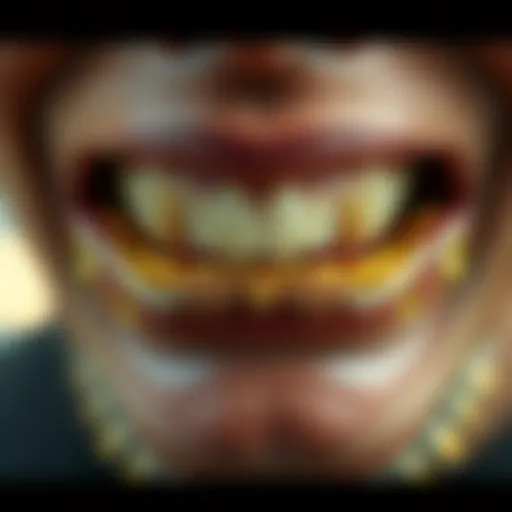Understanding Thigh Chafing Pads: A Comprehensive Guide
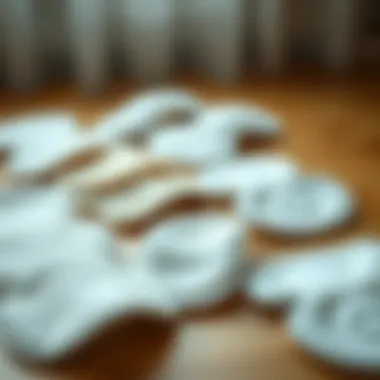

Intro
Navigating through our busy lives often pushes us beyond the limits of comfort. It’s an everyday balancing act of style and practicality, especially when considering clothing choices. Enter thigh chafing pads, an unsung hero in the wardrobe arsenal. Many individuals may overlook their significance, but these pads serve a purpose far beyond what meets the eye. They become indispensable for those who engage in activities that require extended wear of fitted clothing or who navigate the rigors of daily routines.\n\nWhile thigh chafing may seem like a trivial issue to some, it can be a real pain — literally and figuratively. Its effects range from discomfort to skin irritation, and no one wants to cut a day short because their apparel becomes a nuisance. In this guide, we aim to shine a light on the importance of thigh chafing pads, not just as a remedy, but as an essential element of personal care. Stay tuned as we break down their design, functionality, and how to select the right pad that not only maximizes comfort but also enhances your overall style.
Fashion Trends
Current Trends in Clothing
In the ever-evolving fashion landscape, it's crucial to understand how current trends influence our choices, especially when it comes to fitted clothing. Styles that hug the body tend to spike in popularity. Garments like tailored shorts, form-fitting dresses, and leggings are all the rage, showcasing one’s figure. However, this popularity can often lead to an uptick in thigh chafing complaints. Therefore, integrating thigh chafing pads into this mix is not merely practical but also wise.
As the trends lean toward minimalist designs and sustainable fabrics, consider how these clothes interact with your skin. Rough seams or stiff materials can exacerbate chafing, which makes the selection of the right thigh pad vital. Fashion enthusiasts now opt for pads that blend seamlessly with their outfits, maintaining both appearance and comfort.
Seasonal Attire Suggestions
When the seasons change, so do our wardrobe staples. During hotter months, lighter, breathable fabrics dominate, while colder seasons bring thicker materials into play. Each situation presents an opportunity for thigh chafing pads to shine. For instance, during the summer, one might wear cotton shorts, where smooth, soft pads are crucial to prevent irritation.
Conversely, winter attire often involves layers, which can also pose challenges. Opting for thicker pads that provide cushioning and warmth can aid in comfort without sacrificing style. Look for pads that are
- Moisture-wicking
- Breathable
- Thin, yet effective
By selecting the appropriate thigh chafing pads, you’ll not only stay comfortable but will also maintain a polished look, regardless of the season.
"The right pads can transform your daily wear — no fuss, no muss!"
Ending
Once you're equipped with insights on how thigh chafing pads fit into the fashion equation, you're left empowered. Whether it's an athletic endeavor or a long day at work, the right pads not only protect your skin but also enhance your overall outfit. Carefully selecting these pads to match your clothing can enhance your confidence and keep discomfort at bay. Understanding the synergy between fashion and function is the key to navigating any wardrobe challenges.
Preamble to Thigh Chafing
Thigh chafing might not be a topic that tops most people's list of everyday concerns, but to those who experience it, it can be nothing short of a nightmare. This section lays the groundwork for understanding why thigh chafing is significant, how it impacts daily life, and what can be done to alleviate it. The discomfort can affect anyone, regardless of lifestyle, and recognizing its causes is the first step toward effective mitigation.
The discussion of thigh chafing paves the way to comprehending various prevention strategies, prominently featuring chafing pads. These tools are designed not just to prevent irritation, but to enhance overall comfort during activities, whether it's a long day at work or a brisk jog in the park.
In this exploration, we shall demystify the factors that lead to thigh chafing, shedding light on both the physiological and environmental aspects that can trigger it. With a focus on various causes, from friction during movement to the role of body type and the influence of weather conditions, readers will gain valuable insights that could transform their approach to personal care.
The goal is to ensure that, by the time we wrap up this guide, the readers are not only informed about chafing but are also equipped with practical knowledge to address it effectively in their lives.
Defining Thigh Chafing
Thigh chafing occurs when the skin on your thighs rubs together, leading to irritation and discomfort. This condition can escalate into painful rashes or blisters, making it important for anyone who experiences frequent rubbing to seek preventative measures. Understanding the mechanics behind chafing helps to frame how chafing pads fit into the narrative and why they are essential tools for many individuals.
Common Causes of Thigh Chafing
There are several primary factors contributing to thigh chafing; being aware of these can be instrumental in preventing it from becoming an issue. Each cause interacts with elements of body mechanics and the surrounding environment, which is key for understanding how to best protect oneself.
Friction and Movement
Friction is the primary culprit behind thigh chafing. Whenever the thighs move against each other, especially during activities like walking, running, or cycling, they create a rubbing motion that can rub the skin raw. The more vigorous the movement, the greater the friction. More vigorous activities can amplify the chances of this irritating condition occurring. Thus, anyone who engages in sports or active lifestyles might find themselves seeking relief or solutions like thigh chafing pads.
The unique aspect of friction is its variability; for instance, an individual's gait, clothing choices, and even skin hydration can impact how much friction is generated. The ups and downs of running can certainly contribute to it, showing how this issue can touch many aspects of life.
Weather Conditions
Believe it or not, the weather can play a significant role in thigh chafing. Hot, humid days mean more sweat, which can greatly increase friction and lead to irritation. On the other hand, cold, dry air can dry out skin, making it more susceptible to damage when it encounters repeated movement. Additionally, sporting certain fabrics during extreme weather can exacerbate issues of chafing. For instance, wearing cotton in a humid climate might not be the best choice.
Weather conditions achieve an interesting balance, necessitating thoughtful consideration about the type of chafing pads to use—some materials might perform better under sweatier conditions while others excel in drier environments.
Body Type and Shape
Our bodies are wonderfully unique, and their shapes can influence how we experience chafing. Individuals with larger thighs or a shape that sees them touch more often might find themselves struggling with this issue, regardless of their activity level. Factors like body fat distribution and muscle definition also play significant roles.
It’s important to note this as a key characteristic because it reinforces the idea that thigh chafing is not merely an athlete’s concern—anyone can experience it, often regardless of their size. This ongoing struggle highlights the necessity for thoughtfully designed chafing pads that cater to various body types to alleviate discomfort effectively.
What are Thigh Chafing Pads?
Thigh chafing pads are simple yet effective solutions designed to relieve discomfort caused by skin friction, especially in the thigh area. Though the concept might seem straightforward, understanding the function and variety of these pads is crucial for reducing irritation and enhancing comfort during various activities. In this section, we will dissect what thigh chafing pads are, the types available, and their benefits.
Overview of Thigh Chafing Pads
Thigh chafing pads serve a vital role in providing a barrier between the thighs, minimizing direct skin-to-skin contact. This separation is key for anyone who engages in activities that involve prolonged movement or wear snug clothing.
These pads are equipped to absorb moisture and reduce friction, making them especially useful during hot, humid days or for extended physical exertion. They come in various shapes and sizes, allowing users to select the style that suits them best. It's like having a little cushion to save one from those nagging rashes and discomfort.
Different Types of Chafing Pads
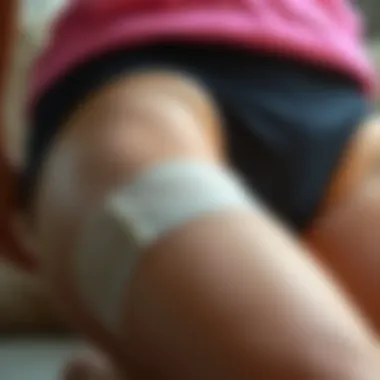

Understanding the types of thigh chafing pads on the market can aid in making an informed choice:
Fabric-Based Pads
Fabric-based pads are made from soft textiles that offer comfort and breathability. These pads often use materials like cotton or moisture-wicking fabrics which allow air to circulate, keeping skin cool and dry.
A key characteristic of fabric-based pads is their flexibility; they can easily conform to body movements without shifting out of place. This adaptability makes them a popular choice for daily wear, as they can seamlessly blend into a range of outfits.
However, one downside might be that they require regular washing to maintain hygiene, which can be a task.
Silicone Pads
Silicone pads provide an innovative option for those seeking a more robust barrier against chafing. They are made of stretchy, skin-friendly silicone that adheres well to the skin, ensuring they stay in place during intense physical activities.
The standout feature of silicone pads is their durability. They can often be reused multiple times, washed easily, and generally do not require frequent replacement. They offer a sleek, discreet alternative for those who dislike the bulkiness of fabric pads.
That being said, while silicone pads are effective, they might not be as breathable. This could lead to potential discomfort in particularly hot conditions, so keep that in mind.
Disposable Options
For those who prefer a fuss-free solution, disposable thigh chafing pads are available. These pads are typically made for one-time use and can be slipped on just like a bandage. They often come individually packaged for hygiene and convenience.
The key characteristic of disposable options is their ease of use. Perfect for travel or when you're in a pinch, they offer a quick, mess-free way to address chafing issues. However, environmental concerns arise since they contribute to waste, which is a factor to consider.
In summary, each type of chafing pad offers specific advantages and potential drawbacks, so knowing the options can empower users to make the best choice for their unique needs.
"Choosing the right thigh chafing pad depends on your lifestyle, activities, and personal preferences. Prioritizing comfort can make all the difference in your daily wear."
Options cater to diverse activities, allowing everyone to find suitable protection against chafing.
Materials Used in Chafing Pads
Selecting the right materials for thigh chafing pads is crucial for their effectiveness and comfort. It can greatly influence how well these pads perform in various situations, impacting both your comfort and skin health. Different materials offer unique benefits, whether it is moisture-wicking capabilities, breathability, or cushioning. Understanding these elements helps you make informed decisions, ensuring that you choose pads that fit your needs and lifestyle.
Natural Fibers
Natural fibers have been a long-standing choice in many personal care products, and chafing pads are no exception. Materials like cotton, bamboo, and silk provide softness and breathability, making them comfortable against the skin.
- Cotton is often favored for its natural absorbent qualities. It allows for good airflow, which decreases sweat accumulation that can exacerbate chafing.
- Bamboo fibers naturally regulate temperature and moisture, making it a great eco-friendly option that also limits bacterial growth, further enhancing skin health.
- Silk, though more luxurious, offers a smooth surface that reduces friction.
These natural fibers usually come with the additional benefit of being biodegradable, an increasingly valued characteristic for eco-conscious consumers. However, they can be less durable in high-friction scenarios, so understanding your specific needs is key.
Synthetic Materials
On the other end of the spectrum, synthetic materials like nylon, polyester, and spandex have gained traction for their robustness and performance benefits. These materials often provide a snug fit, which is useful in preventing shifting, thus reducing the likelihood of chafing.
- Nylon and polyester are renowned for their moisture-wicking properties, quickly drawing sweat away from the skin. This minimizes chafing caused by dampness, allowing you to stay comfortable during long periods of activity.
- Spandex contributes stretch, helping maintain the pad’s shape during movement without losing elasticity. This adaptability can enhance overall comfort.
While synthetic materials may lack some of the breathability of natural fibers, advancements in fabric technology have led to blends that improve airflow while capitalizing on synthetic durability. Choose wisely based on your activity level and environment.
Innovative Designs and Technologies
Innovation in the design and technology of thigh chafing pads cannot be understated. Many manufacturers are now utilizing cutting-edge techniques and materials to create products that significantly enhance comfort and functionality.
Examples include:
- 3D cushioning that molds to your body’s shape, providing targeted relief where you need it most.
- Thermal-regulating fabrics that adapt to temperature changes, keeping you cool when it's warm and warm when it's cool.
- Seamless construction, which reduces friction points and enhances the overall comfort of the pads.
Many brands have also begun integrating antimicrobial properties within their pads, ensuring that they stay fresh even during extended wear.
"The real game-changer comes with the combination of multiple materials, allowing a perfect balance of comfort and support in thigh chafing pads."
Investing in thigh chafing pads that leverage these innovations can lead to noticeable improvements in your everyday comfort, particularly in activities where friction is a given. Understanding the materials involved helps ensure you choose the right type not just for your needs, but for an overall better wearing experience.
Benefits of Using Thigh Chafing Pads
When it comes to dealing with thigh chafing, many people often wonder if thigh chafing pads are worth the investment. The short answer? Absolutely. These specialized pads offer a multitude of benefits that cater to comfort, skin health, and even personal confidence. Let’s delve deeper into the specific advantages that make thigh chafing pads a must-have in many wardrobes.
Enhanced Comfort During Activities
When you're out and about—whether running errands, exercising, or enjoying a leisurely stroll—the last thing you need is discomfort from chafing. Thigh chafing pads are designed to provide a smooth barrier between your thighs and any clothing that may cause friction. This barrier allows for greater freedom of movement. By alleviating the painful rubbing that can occur from walking or running, these pads let you focus on what you're doing rather than the nagging irritation that may otherwise sidetrack you.
- Moisture Management: Many thigh chafing pads also feature moisture-wicking capabilities, which can help keep your skin dry. This is especially useful during warm weather or intense workouts.
- Variety of Sizes and Shapes: They come in various sizes and shapes, catering to different body types and preferences. So, a tighter fit may suit some, while a looser one could be the way to go for others.
The comfort provided by these pads can make a world of difference, allowing you to engage in physical activities without the dread of developing chafed skin.
Prevention of Skin Irritation and Rashes
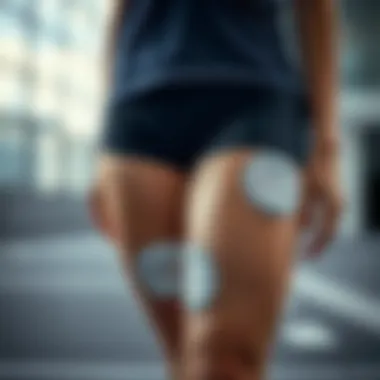

Chafed skin isn’t just an annoying buzzkill; it can lead to serious irritation and rashes if not addressed. Thigh chafing pads act like a protective guardian against these unwelcome occurrences.
- Gentle Materials: Many pads are made from soft, hypoallergenic materials designed to be gentle on the skin. This reduces the risk of inflammation caused by harsh fabrics that can grip or scratch the skin.
- Barrier Effect: By providing a barrier, these pads can also help save you from sweat-induced rashes. This is particularly important for people whose activities naturally produce a lot of sweat, further contributing to irritation.
In short, investing in chafing pads means investing in healthier skin. You can say goodbye to angry red patches and focus on enjoying your day, free from discomfort.
Improved Confidence in Attire Choices
Anyone who has struggled with chafing knows it can be a real confidence killer. The thought of chafing can make you second guess your outfit choices, especially during the warmer months when skirts and shorts become wardrobe staples.
- Freedom to Wear What You Like: With thigh chafing pads, you can wear that cute sundress or fitted shorts without the constant worry of painful friction. This newfound freedom to express yourself through fashion can significantly boost self-esteem.
- Confidence is Key: When you know that you’re protected against chafing, you carry yourself differently. It’s amazing how much of a difference this little piece of protective gear can make, allowing you to strut your stuff with genuine confidence.
"The right apparel can change the way you feel; with the right conditions, it only amplifies it."
How to Choose the Right Thigh Chafing Pads
Selecting the suitable thigh chafing pads is more than just a mere necessity—it's a cornerstone of personal comfort and skin health, especially for those who frequently battle discomfort. Finding the right pads can transform various activities, from casual outings to intense workouts. It’s imperative to delve into a few key elements: size, material, and whether to opt for adhesive or non-adhesive options. With these considerations in hand, you can make an informed decision that caters to your specific needs.
Size and Fit Considerations
When it comes to chafing pads, size matters significantly. You might think one size fits all, but that’s far from the truth. An ill-fitting pad can lead to more friction instead of reducing it. Look for pads that closely match your measurements, that can provide good coverage without bunching up or sliding down during movement. It’s often helpful to take a moment to measure your thigh circumference.
- Too Small: If the pads are too small, they might not cover the necessary area, leaving your skin vulnerable to irritation.
- Too Big: On the other hand, oversized pads can shift around, creating friction and discomfort.
A snug, yet comfortable fit should be the gold standard here. In essence, ensure there's no excess material that could get in the way while walking, running, or cycling.
Choosing the Right Material for Your Needs
Material is another crucial factor to consider when selecting thigh chafing pads. Different materials bring their own set of benefits and limitations, and it’s important to understand them in order to choose wisely.
- Natural Fibers: If you’re sensitive to synthetic materials or prefer natural options, cotton pads might be your best bet. They tend to be more breathable and less likely to irritate sensitive skin.
- Synthetic Materials: Many modern pads feature advanced synthetic fabrics designed to wick moisture away. This can be particularly beneficial during high-intensity activities or in hot weather.
- Hybrid Approaches: Some pads combine synthetic and natural fibers, delivering the comfort of cotton with the performance of modern materials.
In identifying the right choice, think about your specific activities and lifestyle needs. For advanced moisture management, synthetic options might be the route to take.
Evaluating Adhesive vs. Non-Adhesive Options
Lastly, the choice between adhesive and non-adhesive pads can affect your selection process. Both styles have their unique appeal and function well under different circumstances.
- Adhesive Pads: These pads often cling directly to the skin, minimizing the risk of movement during activities. They can offer a secure fit, ideal for intense workouts or strenuous tasks. However, some individuals can find them uncomfortable as they might not allow for skin breathability.
- Non-Adhesive Pads: Non-adhesive variants usually rely on friction alone to stay in place, which can be a hit or miss. They are often easier to remove and apply and can be washed and reused, which is a big plus for folks focused on sustainability.
Ultimately, the best option depends on personal preferences and daily routines. Testing different types can lead you to your much-needed comfort zone.
Usage Scenarios for Thigh Chafing Pads
When it comes to thigh chafing pads, understanding their usage scenarios is crucial. These pads aren't just for the athletic crowd; they play a significant role in multiple areas of daily life. Whether you are jogging early in the morning, cycling through the city, or attending an important meeting, these pads can make a difference in comfort and overall experience.
Athletic and Sport Activities
In the world of sports and fitness, thigh chafing pads become indispensable for those looking to enhance their performance without the distraction of discomfort. Athletes often find themselves focused on their training goals, and the last thing they need is the irritating chafing that can arise from repeated movement. Here’s a deeper dive:
Running
Running requires a consistent repetitive motion that can lead to friction on the thighs, particularly in long-distance or high-intensity runs. The key characteristic here is the continuous leg movement. Thigh chafing pads offer significant relief for runners, allowing them to concentrate solely on their pace and distance rather than the discomfort that often accompanies it. An important feature of these pads for runners is their ability to absorb sweat; this can reduce slippage and keep the pads securely in place, which avoids any potential distractions from getting on with the run.
Advantages:
- Reduces irritation from skin friction.
- Keeps moisture at bay.
Disadvantages:
- May require adjustment until finding the right fit.
Cycling
Cycling presents its own set of challenges. The motion, especially in longer rides, can result in chafing due to the position and movement of the legs against the seat. The benefit of using thigh chafing pads in cycling is their capacity to provide a barrier between the skin and any potentially irritating elements, such as bike shorts or saddles. Comfort during long rides becomes paramount, and these pads contribute significantly to maintaining it. A unique aspect of using pads for cycling is their compatibility with padded shorts, enhancing the overall riding experience.
Advantages:
- Offers added protection from saddle discomfort.
- Compatible with various cycling attires.
Disadvantages:
- May be less effective in hot conditions if not breathable.
Hiking
Hiking involves unpredictable movements across varied terrain, which is where chafing can sneak up on you. The key here is that hikers endure long periods of leg motion, with potential for moisture accumulation leading to chafing. Thigh chafing pads can serve hikers well by preventing skin-to-skin contact, thus shielding against rashes or irritation. Since hikes can range from several hours to days, the durability and comfort of these pads are essential for prolonged use.
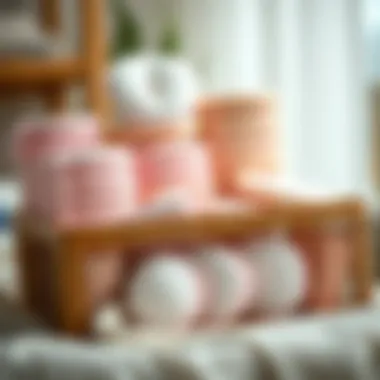

Advantages:
- Provides lasting protection over extended periods.
- Helps maintain comfort during variable conditions.
Disadvantages:
- Can sometimes be cumbersome if not lightweight.
Daily Wear and Professional Use
Beyond athletics, thigh chafing pads have a place in everyday wear and even professional environments. Many people find that whether they're maneuvering through a busy day or remaining seated during meetings, a little extra protection against chafing can improve comfort and focus. Tight-fitting clothes, like skirts or tailored pants, can create friction that these pads effectively alleviate.
Special Occasions and Formal Attire
The importance of comfort doesn't stop at casual wear. For special occasions, wearing outfits that might not typically be comfortable can lead to chafing disruptions, especially under hot lights or during extended events. The right thigh chafing pads can enhance confidence in formal attire, allowing individuals to enjoy gatherings without the nagging irritation that can often occur when wearing fitted clothing.
In summary, thigh chafing pads are a versatile solution that cater to various life scenarios, proving essential for maintaining comfort across active and static environments alike.
Maintenance and Care of Chafing Pads
Maintaining thigh chafing pads may not seem like a high priority, but proper care can significantly extend their lifespan and effectiveness. Just as you wouldn’t neglect a well-loved pair of running shoes, your chafing pads deserve a little attention too. After all, these pads are designed to protect an important area of your body from discomfort. Neglecting their upkeep can lead to diminished performance and, in turn, less protection against chafing. So, let’s deep dive into the essential aspects of maintaining and caring for these pads.
Cleaning Guidelines
Regular cleaning of thigh chafing pads is crucial for various reasons, primarily hygiene and performance. Consider the following cleaning tips to ensure your pads remain in top condition:
- Hand Wash Only: Most chafing pads are made from sensitive materials that can be damaged by vigorous machine washing. It's prefered to wash them gently by hand, using lukewarm water and a mild detergent.
- Avoid Soaking: When cleaning, avoid soaking the pads for extended periods. This can lead to fabric degradation.
- Air Dry: After washing, hang the pads out to dry naturally. Don’t use a dryer as that heat can warp and ruin the material.
- Spot Cleaning: For quick fixes, a damp cloth with a gentle soap can do the trick. This method is especially useful if the pads only have minimal stains or dirt.
Bear in mind that a clean chafing pad not only feels better against your skin but also is more effective at reducing friction.
Storage Recommendations
Proper storage is often overlooked, yet storing your chafing pads correctly can prevent damage and maintain their shape. Here are a few suggestions:
- Cool, Dry Place: Storing your pads in a cool and dry area helps in preventing mold and mildew. These are particularly nasty when moisture gets trapped in fabric.
- Avoid Overlapping: If you have multiple pads, do not stack them directly on top of each other in a drawer. Instead, place them in their own section, or consider hanging them to keep their shape intact.
- Use a Pouch: Keeping your pads in a breathable pouch can also safeguard them against dust and accidental damage.
- Regular Checks: Make it a routine to check the condition of your stored pads. Look for signs of wear and tear that could compromise their functionality.
Proper maintenance and care of chafing pads can enhance their benefits, making your experience more comfortable and ensuring they last longer.
Taking the time to properly clean and store your chafing pads will not only extend their life but also improve their comfort and effectiveness when you need them most.
Addressing Common Myths and Misconceptions
In the realm of personal care and comfort, thigh chafing pads remain a somewhat misunderstood product. It's crucial to dispel the myths surrounding their usage and effectiveness. There are misconceptions that can lead individuals to forgo this beneficial item, which in turn may negatively impact their comfort and skin health.
Myth: Chafing Pads are Only for Athletes
One of the most prevalent myths is that thigh chafing pads are exclusively for athletes. This notion stems from the visibility of these products in sports contexts, but it grossly underestimates their utility in everyday life. The truth is, chafing can affect anyone, regardless of their activity level.
Day-to-day activities such as walking, commuting, or even sitting for extended periods can cause thighs to rub together, leading to discomfort and irritation. It's not just marathon runners or cyclists who are at risk. Individuals with varying body shapes and sizes can experience thigh chafing, making these pads an essential addition to many wardrobes.
Furthermore, chafing pads can be a lifesaver during hot weather or when wearing form-fitting or higher-cut garments. It isn't just about sportswear; it’s about comfort in every outfit choice. By recognizing the broader applicability of chafing pads, one can significantly enhance daily comfort and avoid unnecessary skin trauma.
Myth: All Pads Perform Similarly
The second myth that tends to circulate is the belief that all thigh chafing pads are created equal. This misconception can lead consumers to make uninformed choices, thinking any pad will suffice for their needs.
In reality, the performance of chafing pads can vary greatly based on several key factors:
- Material Composition: Some pads are made from breathable fabrics, while others may incorporate silicone or disposable options. The choice of material can affect breathability, moisture-wicking properties, and durability.
- Adhesive Quality: Not all adhesive options hold up equally well. Some pads provide a secure grip throughout various activities, while cheaper versions may peel off, negating their purpose altogether.
- Design and Shape: The design plays a pivotal role too. Contoured shapes may fit snugly to the thighs, providing better protection compared to flat pads.
Each of these aspects contributes to comfort and effectiveness. Just as different shoes fit differently, the same principle holds true for chafing pads. Those seeking the best results should consider their personal requirements and select products that cater specifically to them.
Remember: Chafing pads aren’t just a luxury for athletes; they're a simple solution for anyone seeking to enhance their everyday comfort and skin health.
By addressing these myths, we pave the way for a deeper understanding of the actual importance and versatility of thigh chafing pads.
Culmination: The Importance of Thigh Chafing Pads
Understanding the role of thigh chafing pads is crucial for anyone looking to enhance their comfort during daily activities or specific events. These simple yet effective products serve as a barrier between your skin and the potentially abrasive forces at play when your thighs rub together. Their significance cannot be overstated, especially when you consider that discomfort can stem from a range of situations.
Chafing pads are key for various reasons:
- Preventative Function: At the heart of their design, these pads aim to prevent skin irritation before it occurs. Whether you’re hitting the trails for a run, cycling to work, or simply enjoying a day out, the pads work wonders in keeping the skin smooth and irritation-free.
- Assurance in Body Confidence: Many people can relate to the hesitation that occurs when choosing outfits. A pair of snug shorts may create anxiety over chafing. By using pads, your confidence takes a leap, allowing you to wear what you want without worry about discomfort.
- Variety for Everyday and Special Use: The beauty of thigh chafing pads lies in their adaptability. Available in several materials and designs, they cater to varied lifestyles—be it an athlete’s rigorous training or someone dressed to the nines for a wedding. The right pad can transform your experience, ensuring you feel great no matter the occasion.
"Don’t let chafing ruin your day—investing in thigh chafing pads is investing in comfort and quality of life."
Beyond their immediate benefits, considering thigh chafing pads is a step towards long-term skin health. It’s not just about the occasional irritation; persistent friction can lead to more severe conditions, including rashes or, worse, skin infections. And nobody wants that!
In summary, recognizing the importance of thigh chafing pads helps illuminate their value, whether for athletic wear, daily activities, or special occasions. Comfort, skin health, and being able to express oneself confidently through clothing are essential components of well-being in every facet of life.
Final Thoughts on Comfort and Skin Health
Opting for quality thigh chafing pads not only keeps discomfort at bay but also acts as a significant ally in promoting healthier skin. The skin deserves protection against unnecessary friction, and these pads are a straightforward solution. When considering overall fashion with functionality, integrating thigh chafing pads into your wardrobe choices is a smart move, helping ensure you feel your best, no matter where your day takes you.

